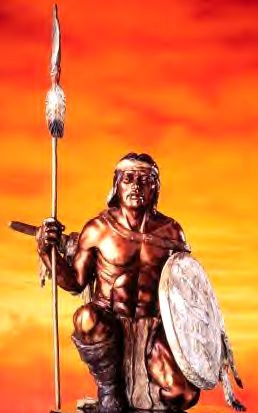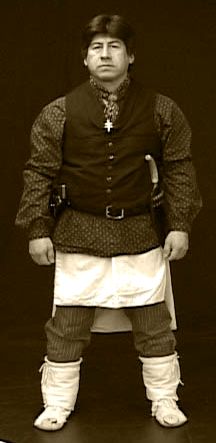Apache History
The origin of the
name
Apache
remains unclear to this date; however, the name probably stems from the name
‘Zuni apachu’ which was the name for the Navajo. The early Spaniards called the
Navajo ‘Apaches
de Nabaju’. However, Geronimo told a more interesting story. “In the
beginning, the world was covered in darkness. There were all manner of beasts
and birds. Mankind could not prosper for the beasts and serpents destroyed all
human offspring. All creatures did have the power of speech and were gifted
with reason. There were two tribes of creatures: the feathered tribe consisting
of birds and the beasts. The birds wanted light admitted, yet the beasts did
not, so the
birds made war against the beasts.
 The
birds eventually won the war; however, the dragon still lived. There were only
a few human beings alive and one happened to be a woman and every time she had a
baby, the dragon would eat her baby. Years later, she had a baby boy and placed
him in a deep cave to protect him. She covered the cave so that she could build
a fire to keep the baby
warm. Numerous
times, the dragon would ask her about the baby, but she would tell the dragon
that she had no more babies. As the boy grew older, his uncle built him a bow
and arrow and took him hunting. One day during a hunt, the dragon appeared.
The boy was not frightened, yet the uncle was so frightened that he could not
move. The boy asked the dragon if he wanted to fight and the dragon agreed.
They each took four arrows, stood 100 paces from
each other, and each exchanged four consecutive shots with the dragon going
first. Each time, the boy eluded the dragon’s arrows. The dragon had four
coats of scales and no arrows had ever penetrated the dragon’s armor. The boy
shot his first arrow striking the dragon just over the
heart and broke
one set of scales. Each shot
struck the same spot breaking a set of
scales each time. Finally, the fourth arrow pierced the dragon’s heart killing
the dragon. The boy’s name was
Apache.
The
birds eventually won the war; however, the dragon still lived. There were only
a few human beings alive and one happened to be a woman and every time she had a
baby, the dragon would eat her baby. Years later, she had a baby boy and placed
him in a deep cave to protect him. She covered the cave so that she could build
a fire to keep the baby
warm. Numerous
times, the dragon would ask her about the baby, but she would tell the dragon
that she had no more babies. As the boy grew older, his uncle built him a bow
and arrow and took him hunting. One day during a hunt, the dragon appeared.
The boy was not frightened, yet the uncle was so frightened that he could not
move. The boy asked the dragon if he wanted to fight and the dragon agreed.
They each took four arrows, stood 100 paces from
each other, and each exchanged four consecutive shots with the dragon going
first. Each time, the boy eluded the dragon’s arrows. The dragon had four
coats of scales and no arrows had ever penetrated the dragon’s armor. The boy
shot his first arrow striking the dragon just over the
heart and broke
one set of scales. Each shot
struck the same spot breaking a set of
scales each time. Finally, the fourth arrow pierced the dragon’s heart killing
the dragon. The boy’s name was
Apache.
Apaches were trained for war from boyhood. Boys woke early and bathed in the river, even if they had to crack the surface ice to do so. They ran up hillsides with a mouthful of water to learn correct breathing through the nose – the endurance so characteristic of the Apaches. Boys were hardened by rough wrestling games, mock battles, and taught by their relatives the geography, attributes, and sanctity of their surroundings.
When a young man felt ready, he would begin the novice warrior complex of his first four raids, which were permeated with religious beliefs and rituals. Having been accepted as a member of his first raid, the young man was instructed by a war shaman. The shaman would give the young man a drinking tube, a scratcher, and a special war cap, which unlike those of the mature warrior did not bestow spiritual power. The apprentice warrior was sacred and was identified with their cultural hero called Child of the Water. The young Apache used the ceremonial warpath language, which replaced words for common objects during the raid. The scratcher was used to scratch him and the drinking tube to ensure water did not touch the lips. When eating, the young Apache would eat only when the food was cold in order to bring the raiders good luck. He was also subservient to the other warriors and would fetch their water and wood. If he did well on the first raid, he would be invited back for another raid. Upon completing four successful raids without deviations in his conduct, the young Apache received the coveted reward of recognition as an Apache warrior.
The legendary skill and endurance of the Apache warriors has been documented through the testimonies of the soldiers who fought them. They even referred to them as the ‘tigers of the human race’ and were ideally adapted to fighting in their rugged homeland. Warriors wore a shirt, breechclout, and moccasins normally reaching above the knee; he carried a rope, blanket, water jar, fire drill, rations of mescal or jerky, and his weapons. The Apache might employ a shield, bow, arrows, lance, club, knife, and during the Apache Wars, a gun and cartridge belt. They also blackened their weapons to camouflage them.
Apaches lived instinctively off the land and could withstand extraordinary extremes of thirst and hunger. Paint was daubed across the face to invoke the particular power of a war shaman. In fact, Geronimo was a war shaman whose power allegedly enabled him to predict events and prevented him from being killed by bullets. The Apaches did not adapt a horse culture, as their terrain and lifestyle did not lend itself to the adoption of the horse in the same way as did that of the Plains Indians. Horses were used in large raids, but an Apache warrior was equally likely to travel on foot, allowing him to use the terrain to conceal his movement. An Apache warrior could run as many as 70 miles a day, and Apache women thought nothing of trotting 60 miles to present treats to their children when they had been placed in boarding schools in later years.
Concealment was a spectacular trait amongst the Apaches. In one instance, Quick Killer told a soldier to turn his back and in an instant had disappeared. In a spot just a few feet away, he emerged after completely burying himself under thick grass.
The Apaches fought a guerrilla style of warfare against the Spanish, Mexicans, and Americans. Hardly any pursuers every successfully found their way into the labyrinthine strongholds of the Apache Indians until they learned to turn Apache against Apache, utilizing the remarkable ability of the Apache scouts. When the Apaches were chased, they would scatter, running across rock to an agreed rendezvous, leaving no trail. They would visit their secret waterholes at night, which they knew well or could quickly spot from high ground. If they felt they were being cornered, they would kill their horses and climb like deer up seemingly impassable cliff sides.
Tricky as they were, Apaches would build false camps to confuse the enemy and drive their livestock several miles ahead of the actual area where a group concealed themselves. Camps could be moved silently and were at times moved right under the noses of the Apache enemies. Fight or flight, the Apaches were very skilled in doubling back like a fox and ambushing their pursuers.
The death ceremony was very sacred. When an Apache warrior passed away, his watchers would close his eyes, array him in his best clothes, paint his face, wrap a rich colored blanket around him, saddle his favorite horse, place him on the horse and lead him to a cave in the mountains.
The watchers then killed all of his horses, gave away his property, and hid the cave with stones.
![]()

Nzgondzoog- war/fight (Old term)
Nagonistl'od- he is fighting dv: Nagonistl'og
Nagonistl'og- he is fighting dv: Nagonistl od
Nagonlkaad- he makes war/fights dv: Nagonlkaag
Nagonlkaadi- war/fight/combat dv: Nagonlkaagi Nagondzoog
Nagonlkaadna- when they went to war dv: Nagonlkaagna
Nagonlkaadyu- they go to war dv: Nagnlkaadna
Nagonlkaagyu- they go to war dv: Nagonlkaadyu
Nagoni'i- story
The People Called Apache
The Western Apache, The Chiricahua Apache, The Mescalero Apache, The Jicarilla Apache,
The San Carlos Apache, The Kiowa Apache, The Lipan Apache, The Navajo Apache.
Robert Redfeather Mescalero Apache Scout, Who Teaches Basic Tracking skills to the US Army and Law Enforcement and now you!
Apache Language you should know. good luck!
(714) 943-8127
Click here for The Apache Knife Combat Scouts: A Way of Life
Mail to Robert Redfeather 12340 Seal Beach Bl. Seal Beach, CA. 90740
![]()
Click here for GERONIMO HISTORY.
Click here for THANKSGIVING ITS TRUE HISTORY.
Dao Go Te' doo
Hondah
Means to say It is good we meet
and welcome.
| Home | Testimonials | Knife Fighting |
| R. Redfeather | Apache History | Seminars |
| School | Knife | What's new? |
| Other Links | Knife DVD | Guestbook |
| Association | Knife Tournament | Tuition |
| US. Military | Fallen Warriors |
All materials contained in this electronic domain are protected by copyright and trademark laws and may not be used for any purpose whatsoever other than private, non-commercial viewing purposes. Derivative works and other unauthorized copying of use of text, stills, graphics, or video footage, without prior written consent, are expressly prohibited.
Copyright © 1993-2014 Robert Redfeather. All Rights Reserved
Apache-Knife.com®